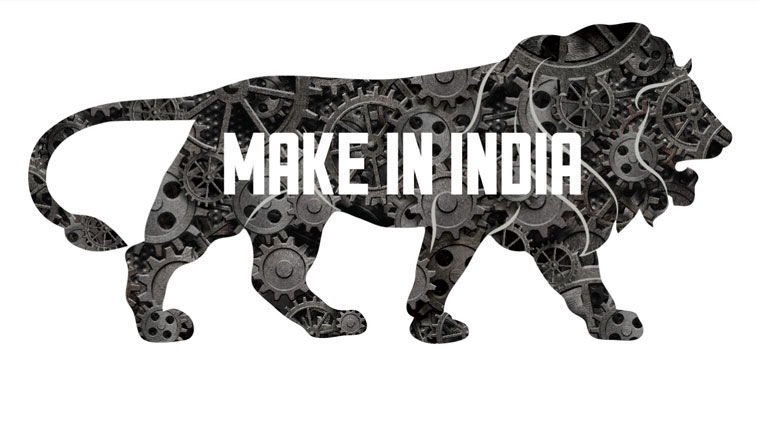 We grew up learning that India is an economy that is overwhelmingly dependent on agriculture – the vagaries of monsoons, of droughts and flood, etall. Post liberalization, the picture changed and almost overnight, agriculture was sent to the backburner of our consciousness, as we reinvented ourselves as a service led economy, a sweat shop where the world outsourced their business and knowledge processes from. Not that our industry was of any less significance though – Pundit Nehru fondly christened them as the temples of Modern India, but somehow the gigantic steel plants or our indigenously manufactured automobiles or even the watches that kept time for the Nation, did not really cut much ice. Yes, stray winners did emerge: entities that held their manufacturing heads high among the global giants, but they were exceptions, rather than being the rule. Somehow, we never reached the point where we could ourselves believe in India’s manufacturing prowess, especially on a global scale; leave alone vouch for it enough to embrace the Made in India tag.
We grew up learning that India is an economy that is overwhelmingly dependent on agriculture – the vagaries of monsoons, of droughts and flood, etall. Post liberalization, the picture changed and almost overnight, agriculture was sent to the backburner of our consciousness, as we reinvented ourselves as a service led economy, a sweat shop where the world outsourced their business and knowledge processes from. Not that our industry was of any less significance though – Pundit Nehru fondly christened them as the temples of Modern India, but somehow the gigantic steel plants or our indigenously manufactured automobiles or even the watches that kept time for the Nation, did not really cut much ice. Yes, stray winners did emerge: entities that held their manufacturing heads high among the global giants, but they were exceptions, rather than being the rule. Somehow, we never reached the point where we could ourselves believe in India’s manufacturing prowess, especially on a global scale; leave alone vouch for it enough to embrace the Made in India tag.
Naturally, we did not move into the next orbit – that of packaging India as a destination – as a manufacturing base for the world. Skeptics were a dime a dozen and arguments like the lack of basic infrastructure required to sustain global scale manufacturing; or the woefully low levels of productivity of our labour; or the high cost of production throwing us out of the arena off competition; or even the lack of a comprehensive, business friendly legal framework; or stifling bureaucratic control and the lack of an environment conducive to industrial production were bandied about with gay abandon at the very mention of the topic.
Make in India wants to set all that right, that too, in one fell sweep.
Make in India is a major pan-India programme of the Government of India designed to facilitate investment, foster innovation, enhance skill development, protect intellectual property and build best in class manufacturing infrastructure in the country. The primary objective of this initiative is to attract investments from across the globe and strengthen India’s manufacturing sector. It is being led by the Department of Industrial Policy and Promotion (DIPP), Ministry of Commerce and Industry, Government of India.
The Make in India programme, when implemented has the potential of changing the very face and structure of the Indian economy as it aims at utilising the existing Indian talent base, creating additional employment opportunities and empowering the secondary and the tertiary sectors, with all the attending spin-off’s. The programme also aims at improving India’s rank on the Ease of Doing Business index by eliminating the unnecessary laws and regulations, making bureaucratic processes easier, making the government more transparent, responsive and accountable – in short, cut through the red tape
“I want to tell the people of the whole world: Come, make in India. Come and manufacture in India. Go and sell in any country of the world, but manufacture here. We have skill, talent, discipline and the desire to do something. We want to give the world an opportunity that come make in India,” Prime Minister of India, Hon Sri Narendra Modi said while introducing the programme in his maiden Independence Day speech from the ramparts of the Red Fort on August 15, 2014. The initiative was formally introduced on September 25, 2014 by Sri Modi at Vigyan Bhawan, New Delhi, in the presence of business giants from India. Since then, massive strides have been taken to ensure that we live up to the lofty dreams that we have set as an agenda before the Nation.
To make matters simple and focused, the center of attention of Make in India programme is on 25 sectors. These include: automobiles, aviation, chemicals, IT & BPM, pharmaceuticals, construction, defense manufacturing, electrical machinery, food processing, textiles and garments, ports, leather, media and entertainment, wellness, mining, tourism and hospitality, railways, automobile components, renewable energy, biotechnology, space, thermal power, roads and highways and electronics systems. It goes without saying that in each of these identified segments India enjoys a significant advantage, natural or otherwise and can, with the right inputs, scale up to challenge the world leaders. She can also play hostess to the key players from around the world in their desire to maintain their edges even as they go about dominating the world.
In keeping with the times, the Make in India initiative too has been armed with a significant backing in the digital domain where it is sought to establish connects with those that matter in the world. As a matter of fact, the dedicated website for this initiative (www.makeinindia.com) not only showcases the 25 sectors but also puts focus on the live projects like industrial corridors and policies in the area of foreign direct investment, national manufacturing, intellectual property and new initiatives. The Investor Facilitation Cell is an integral part of this website, which aims at providing all information/data analysis to investors across sectors. The concept of a single-window for those who want to come forward and take part in the process, has literally been embedded on Windows.
Take the Industrial Corridors for example. Five industrial corridor projects have been identified, planned and launched by the Government of India in the Union Budget of 2014-2015, to provide an impetus to industrialisation and planned urbanisation. In each of these corridors, manufacturing will be a key economic driver and these projects are seen as critical in raising the share of manufacturing in India’s Gross Domestic Product from the current levels of 15% – 16% to 25% by 2022. Along these corridors, the development of 100 Smart Cities has also been envisaged in the Union Budget of 2014-2015. These cities are being developed to integrate the new workforce that will power manufacturing along the industrial corridors and to decongest India’s urban housing scenario. A National Industrial Corridor Development Authority (NICDA) is being established to converge and integrate the development of all industrial corridors.
The Amritsar –Kolkata Industrial corridor, to cite an example, a part of this initiative, seeks to link the Eastern parts of the country with the North and the West and act as the major driver of economic growth of east India, with all its attending benefits.
The idea is simple – put the maximum thrust on manufacturing, attract the biggest and the best in class from around the world to collaborate and build the infrastructure around manufacturing to provide a seamlessly integrated system that is not only efficient but is also cost competitive and capable of meeting any challenge to hold its own. By attracting the right kind of investment leading to the unleashing of the nation’s manufacturing potential, the programme will seek to let the multiplies get into play, which will in turn add to the synergies and creating enough velocity for the economy to transit into the next orbit of prosperity.
The Make in India initiative, has become the largest and fastest growing government initiative ever with over 2.1 billion global impressions on social media and has reached an overall fan base of over 3 million on its Facebook page, according to an official release that was issues soon after its launch. The current figures are too mindboggling to be recounted here. Suffice to say, the programme seems to have touched a raw nerve of the Nation, especially the youth, who are leading this resurgence, ready to keep their collective tryst with destiny. The entire process has been backed by a blitzkrieg in the global and the local media which has provided a huge facelift to the image of the Nation and will work for years to come, showcasing India as the new destination for manufacturing investments.
 (Tristha Sharma having completed her graduation from a leading city based college, is now pursuing a course in Corporate Communications and is a keen follower of all matters economic. A firm believer in the economic potential of India, Tristha believes that India’s ascent to the pinnacle of socio-economic development is a matter of time, if all of us Indians just do our bit for the nation even as we go about fulfilling our own, private economic agendas.
(Tristha Sharma having completed her graduation from a leading city based college, is now pursuing a course in Corporate Communications and is a keen follower of all matters economic. A firm believer in the economic potential of India, Tristha believes that India’s ascent to the pinnacle of socio-economic development is a matter of time, if all of us Indians just do our bit for the nation even as we go about fulfilling our own, private economic agendas.
Tristha is idealistic to a fault and wants to pursue a career in journalism, reporting about all the positive things that go unreported so as to spread the good word, literally.
The story was written for the Make in India supplement of the Indian Express and the Financial Express.)
